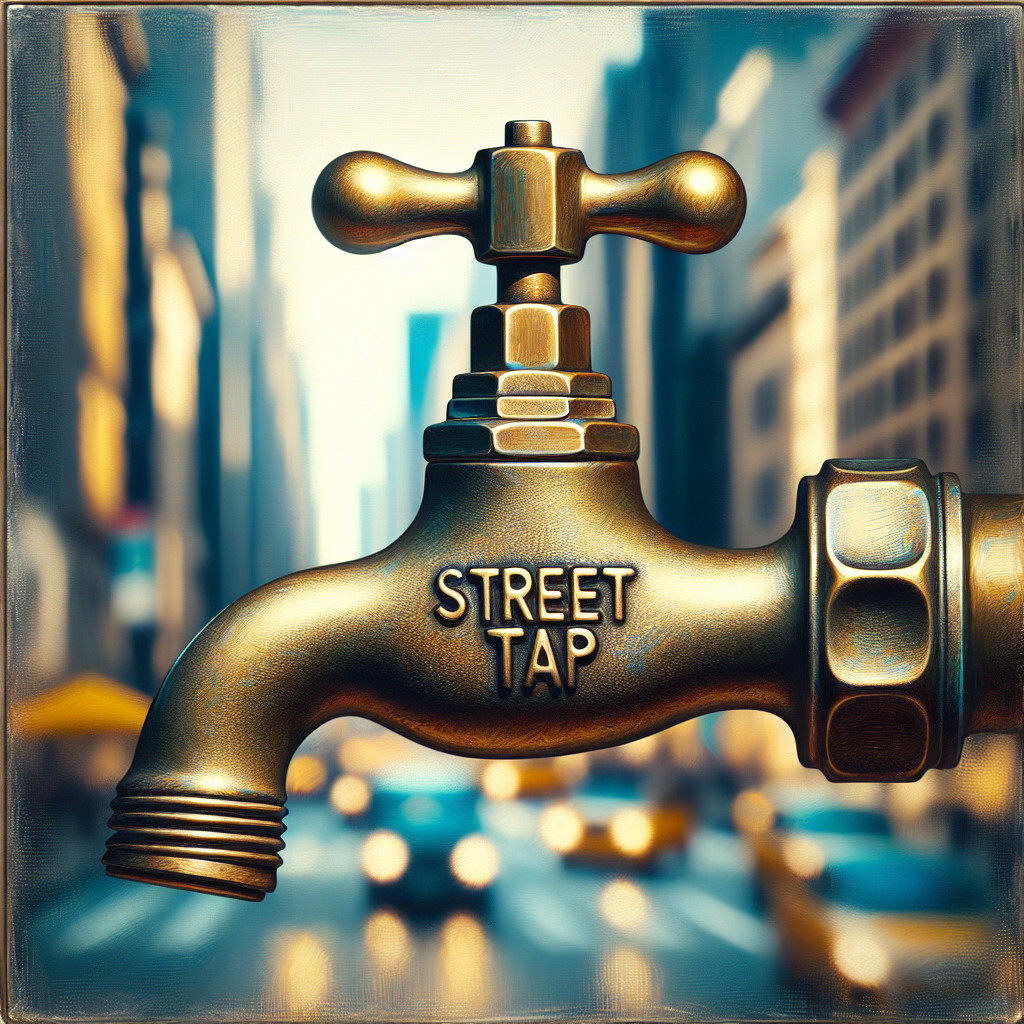-
Table of Contents
“Hydrate Now”
Introduction

A hydrant is a street water tap that is primarily used by firefighters to quickly access water during emergencies.
Understanding the Importance of Street Water Taps
Street water taps, also known as public standpipes, are a crucial part of urban infrastructure, particularly in developing countries. These taps, often simply referred to as hydrants, play a significant role in providing access to clean, safe drinking water for many people, especially those living in low-income areas. They also serve as a vital resource during emergencies such as fires or natural disasters.
The importance of street water taps cannot be overstated. In many parts of the world, access to clean water is not a given. According to the World Health Organization, approximately 785 million people lack a basic drinking-water service. This is where street water taps come into play. They provide an accessible and often free source of water for those who might otherwise struggle to obtain it.
Street water taps are typically installed and maintained by local municipalities or water service providers. They are strategically placed in areas where access to clean water is limited, such as in densely populated urban areas or in regions where water scarcity is a significant issue. The water supplied through these taps is usually treated and safe for consumption, making them a reliable source of potable water.
In addition to providing access to clean water, street water taps also play a crucial role in emergency situations. Firefighters rely on these taps as a source of water to combat fires. In the event of a natural disaster, such as an earthquake or flood, these taps can provide a lifeline, supplying water when other sources may be compromised or unavailable.
However, the management and maintenance of street water taps present several challenges. Ensuring that the water supplied is consistently safe for consumption requires regular testing and treatment, which can be costly and time-consuming. Additionally, these taps can be prone to misuse or overuse, leading to water wastage. This is particularly problematic in regions where water scarcity is a pressing issue.
Despite these challenges, the benefits of street water taps far outweigh the drawbacks. They are a cost-effective solution to the global water crisis, providing a lifeline to those who might otherwise have no access to clean water. Moreover, they play a crucial role in emergency response, providing a readily available source of water to combat fires or mitigate the impact of natural disasters.
In conclusion, street water taps, or hydrants, are an essential part of urban infrastructure. They provide access to clean, safe drinking water for millions of people worldwide, particularly in low-income areas and regions where water scarcity is a significant issue. They also serve as a vital resource during emergencies. Despite the challenges associated with their management and maintenance, the importance of street water taps in ensuring access to clean water and in emergency response cannot be overstated. As such, continued investment in the installation, maintenance, and management of these taps is crucial to addressing the global water crisis and ensuring the health and safety of communities worldwide.
Maintenance Tips for Street Water Taps
Street water taps, also known as hydrants, are an essential part of our urban infrastructure. They provide a crucial source of water for firefighting and other emergency situations, and also serve as a convenient access point for maintenance and testing of the water supply system. However, like any other piece of equipment, street water taps require regular maintenance to ensure they function properly when needed.
The first step in maintaining a street water tap is regular inspection. This involves checking the tap for any visible signs of damage or wear and tear. Cracks, leaks, or rust can all indicate that the tap may not function properly in an emergency. It’s also important to check the surrounding area for any signs of water leakage, as this could indicate a problem with the underground pipes.
After the visual inspection, the next step is to test the tap’s functionality. This involves turning the tap on and off to ensure it operates smoothly. If the tap is difficult to turn or doesn’t shut off completely, it may need to be repaired or replaced. Additionally, the water flow rate should be tested to ensure it meets the required standards. If the flow rate is too low, it could indicate a blockage in the pipes or a problem with the water pressure.
Cleaning is another important aspect of street water tap maintenance. Over time, dirt and debris can build up on the tap, potentially causing it to become blocked or difficult to operate. Regular cleaning can help to prevent these problems. This can be done using a simple brush and soapy water, although more stubborn dirt may require a specialized cleaning product.
In addition to these regular maintenance tasks, it’s also important to be aware of the potential for vandalism. Street water taps can be a target for vandals, who may damage them or use them to waste water. To help prevent this, many cities install lockable caps on their taps, which can only be removed with a special key. These caps can be a very effective deterrent, but they also need to be checked regularly to ensure they haven’t been damaged or tampered with.
Finally, it’s worth noting that while regular maintenance can help to prolong the life of a street water tap, it’s not always possible to prevent all problems. Sometimes, despite our best efforts, taps can fail or become damaged beyond repair. In these cases, it’s important to have the tap replaced as soon as possible to ensure the safety and reliability of the water supply system.
In conclusion, maintaining street water taps is a crucial task that requires regular inspection, testing, cleaning, and vigilance against vandalism. By following these steps, we can help to ensure that our taps continue to function properly and provide a reliable source of water for emergencies. And while it’s not always possible to prevent all problems, by acting quickly when issues do arise, we can minimize the impact on the water supply system and the community as a whole.
The Role of Street Water Taps in Public Hygiene
Street water taps, also known as public standpipes, play a crucial role in maintaining public hygiene, particularly in developing countries and urban areas with limited access to clean water. These taps, often managed by local authorities or community organizations, provide a lifeline for millions of people worldwide, ensuring access to clean, safe water for drinking, cooking, and cleaning.
The importance of street water taps in public hygiene cannot be overstated. Access to clean water is a fundamental human right, and it is also a cornerstone of public health. Waterborne diseases such as cholera, typhoid, and dysentery can spread rapidly in areas without access to clean water, leading to outbreaks that can devastate communities. By providing a reliable source of clean water, street water taps help to prevent these diseases and promote overall community health.
Moreover, street water taps also play a significant role in promoting personal hygiene. Regular handwashing is one of the most effective ways to prevent the spread of diseases, particularly those that are transmitted through direct contact or respiratory droplets. In areas where access to clean water is limited, street water taps provide a vital resource for individuals to maintain personal cleanliness and reduce the risk of disease transmission.
In addition to their role in disease prevention, street water taps also contribute to the overall quality of life in communities. Access to clean water is not just about health; it is also about dignity and social equity. For many people, particularly those living in poverty, the ability to wash, cook, and clean with clean water can make a significant difference in their daily lives. Street water taps help to level the playing field, ensuring that everyone, regardless of their economic status, has access to this basic human necessity.
However, despite their importance, street water taps are often overlooked in discussions about water security and public health. Many taps are poorly maintained or inadequately monitored, leading to issues with water quality and reliability. In some cases, taps may be located far from the communities they serve, making access difficult, particularly for vulnerable populations such as the elderly or disabled.
To maximize the benefits of street water taps, it is essential that they are integrated into broader strategies for water management and public health. This includes regular maintenance and monitoring to ensure water quality, as well as strategic placement to ensure accessibility. Community involvement can also play a key role in the success of street water taps, as local residents are often best placed to manage and maintain these resources.
In conclusion, street water taps play a vital role in promoting public hygiene and health, particularly in areas with limited access to clean water. By providing a reliable source of clean water for drinking, cooking, and cleaning, these taps help to prevent the spread of diseases, promote personal hygiene, and improve the overall quality of life in communities. However, to fully realize these benefits, it is crucial that street water taps are adequately maintained, strategically located, and integrated into broader public health strategies.
Innovations in Street Water Tap Designs
Street water taps, also known as public standpipes, are a crucial part of urban infrastructure, providing access to clean water for many communities worldwide. Over the years, these taps have undergone significant transformations, with innovative designs emerging to address various challenges. These innovations, often encapsulated in a simple nine-letter word, ‘hydrant’, have revolutionized the way we access and use water in public spaces.
The traditional design of street water taps was simple and functional, primarily aimed at providing easy access to water. However, these designs often lacked efficiency and sustainability, leading to water wastage and frequent maintenance issues. Recognizing these challenges, engineers and designers began to explore new ways to improve the functionality and efficiency of street water taps.
One of the most significant innovations in street water tap design is the introduction of sensor-based taps. These taps use infrared sensors to detect the presence of an object, such as a hand or a water container, and automatically turn on the water flow. This not only eliminates the need for physical contact, reducing the spread of germs, but also significantly reduces water wastage as the tap automatically turns off when the object is removed.
Another innovative design is the use of solar-powered street water taps. These taps harness the power of the sun to pump water, making them an excellent solution for areas with limited or unreliable electricity supply. Moreover, solar-powered taps are environmentally friendly, contributing to the global efforts to reduce carbon emissions.
In addition to these technological advancements, there has also been a focus on improving the durability and resilience of street water taps. Many modern designs now feature robust materials such as stainless steel and high-grade plastic, which can withstand harsh weather conditions and heavy usage. This not only extends the lifespan of the taps but also reduces maintenance costs.
Furthermore, the aesthetics of street water taps have not been overlooked in these innovations. Designers are now creating taps that are not only functional but also visually appealing. These taps often feature sleek, modern designs and come in a variety of colors and finishes, adding a touch of elegance to public spaces.
The integration of smart technology into street water tap design is another noteworthy innovation. Smart taps can be remotely monitored and controlled, allowing for real-time tracking of water usage and early detection of leaks or malfunctions. This not only enhances water management but also aids in the timely repair and maintenance of the taps.
In conclusion, the humble street water tap, or ‘hydrant’, has come a long way from its traditional design. Through innovative designs and technological advancements, these taps have become more efficient, sustainable, durable, and aesthetically pleasing. As we continue to face global water challenges, these innovations in street water tap design will undoubtedly play a crucial role in ensuring access to clean water for all.
Q&A
Question 1: What is a 9-letter term for a street water tap?
Answer 1: Hydrant.
Question 2: What is the primary function of a 9-letter street water tap, also known as a hydrant?
Answer 2: Firefighting.
Question 3: What color is a typical 9-letter street water tap, or hydrant, in the United States?
Answer 3: Red.
Question 4: What is the pressure range for a 9-letter street water tap, or hydrant?
Answer 4: 30-200 PSI.
Conclusion
Hydrant






